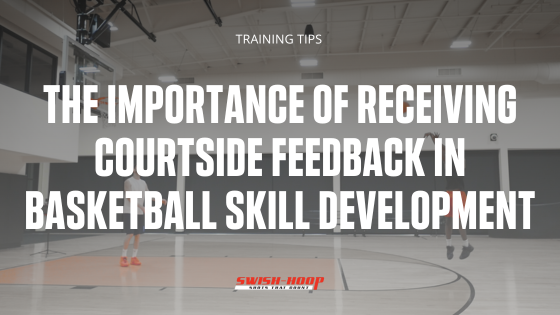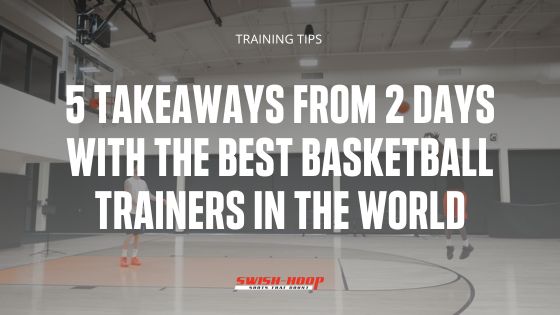When basketball players practice on their own time, there's typically no data-tracking or feedback going on in their practice. Of course not every player is as ambitious about their improvement as others, so just practicing without intention works for some. And while historically most basketball players have been able to improve without data, it's worth wondering how much potential is left on the table when we don't use valuable data, insights and feedback that help us know how to improve even more.
Athletes that are serious about their development and especially those at the highest levels rely on feedback to fine-tune their skills and reach new levels of excellence. Both immediate and delayed feedback play vital roles in measuring performance within skills improvement programs. In this blog, we will dive into the advantages of both types of feedback and explore how they contribute to the growth of basketball players who work on their game.
Immediate Feedback: Enhancing Learning in Real-Time
Immediate feedback refers to receiving information about performance immediately after an action or task is completed. For example, you take a jump shot and immediately are notified that your shot was flat or had great arc. Immediate feedback serves as a powerful tool for athletes seeking to refine their skills and make adjustments in real-time for a few reasons:
- Enhancing Skill Acquisition: According to a study published in the Journal of Motor Learning and Development, immediate feedback during skill acquisition significantly improves learning outcomes. The study found that athletes who received immediate feedback displayed faster skill acquisition and greater accuracy compared to those who received delayed feedback (Chiviacowsky et al., 2012).
- Motivation and Corrective Actions: Immediate feedback provides athletes with an opportunity to correct mistakes and adjust promptly. As Dr. Joan Vickers, a sport psychologist and expert in motor skill learning, notes, "Immediate feedback is vital because athletes can make immediate adjustments based on the information they receive" (Vickers, 2007). This timely input fuels motivation and facilitates skill improvement.
- Greater Attention: Because basketball players know that they are “being tracked” for each shot they take, they are more likely to be laser-focused on the present moment, have greater concentration and are less likely to be distracted.
Delayed Feedback: Reflection and Long-Term Growth
Delayed feedback is another helpful mode of improvement that refers to information provided to athletes after a time lag, allowing for reflection and the consolidation of learning experiences. It offers unique advantages that complement immediate feedback.
- Consolidation of Learning: A study published in the Journal of Experimental Psychology: Applied found that delayed feedback facilitates the consolidation of motor skills. The research revealed that delayed feedback provided opportunities for mental rehearsal and self-reflection, leading to enhanced skill retention (Patterson & Lee, 2010).
- More Detailed Understanding: By reviewing feedback after the activity is completed, athletes may delve into more aspects of the way they execute their skill and the variety of ways they may consider improving. For example, delayed feedback on an athlete's shot can provide feedback on stance, arm position, ball location on the hand and release timing, the combination of which would be difficult to provide in immediate feedback.
- Transfer to Competition: Delayed feedback allows athletes to bridge the gap between practice and competition. Dr. Richard Schmidt, a prominent expert in motor learning and performance, highlights that delayed feedback promotes the development of self-regulation skills, enabling athletes to adjust their performance during competitive situations (Schmidt, 2011).
Finding the Balance: Integrated Feedback Strategies
The benefits of immediate and delayed feedback are not mutually exclusive. An effective skills improvement program integrates both types of feedback to optimize athlete development.
A study published in the Journal of Sports Sciences emphasizes the importance of an integrated approach, stating that "a combination of immediate and delayed feedback is necessary to enhance motor skill learning and transfer to competition" (Hodges & Kerr, 2018).
Another study by Khanfar (2010) showed that the combination of instant feedback plus delayed feedback showed significant improvement in basketball layup skills as compared to groups receiving one or the other type of feedback (but not both).
The Right Technology For You: Feedback from the Swish Hoop® Technology
The Swish Hoop® ecosystem has attributes that provide both types of feedback: the Personal Scoreboard (a component of the Swish Hoop® Basketball Skills Trainer system) provides immediate courtside feedback after each shot and the Swish Hoop® Player app used in conjunction with the Swish Hoop® Shot Monitor provides a rich variety of delayed feedback.
Swish Hoop® is a great way to collect shooting data simply and automatically during practices that may be used to generate feedback for skills improvement. Utilization of the Swish Hoop® Shot Monitor in conjunction with the Swish Hoop® Player App can provide delayed feedback through the following:
- Automatically generated zone and location shot charts: These highlight shooting percentages at different court locations and can highlight where more practice may be required
- Time-based graphing: Swish Hoop® automatically generates charts illustrating shot percentages over time, which are useful for tracking changes as skills improve
- Automated video breakdown: This feature makes it easy to view videos of individual shots rather than endlessly searching long practices. This helps to quickly focus in on certain instances where both self-assessment and outside feedback (from a coach) can help find areas to improve
- Coach comments on videos: The Swish Hoop® Coach’s App gives coaches and trainers a portal to view players’ individual shot videos and make comments and illustrated overlays for precise player feedback
Practicing with the Swish Hoop® Basketball Skills Trainer adds the additional dimension of immediate feedback to all the benefits of delayed feedback. The Swish Hoop® Personal Scoreboard, which comes in the Skills Trainer, can provide immediate feedback through the following:
- Shooting stats: After each shot, the highly visible Swish Hoop® Personal Scoreboard displays makes vs. attempts without needing to be distracted by looking at a mobile device
- Streak count/on-fire: By constantly displaying the running streak of makes, the scoreboard provides a strong visual incentive for continuing the streak. The animated fire display when the streak count reaches three or greater is an additional feedback tool to incentivize success
- Complex drill guidance: The Swish Hoop® Personal Scoreboard displays the court location where players should execute their next shots. This can help generate feedback on more complex drills that include significant movement across the court
- Win/loss results: Nothing provides incentives like a little competition. The Swish Hoop® Personal Scoreboard provides immediate results (who won and who lost) of Side-by-Side and LIVE-Head-to-Head challenges between two players
In the realm of athlete skill improvement, both immediate and delayed feedback hold immense importance. Immediate feedback aids real-time adjustments and fuels motivation, while delayed feedback fosters reflection, consolidation of learning, and the transfer of skills to competitive settings.
As basketball players seek growth and excellence, using Swish Hoop® to incorporate the strategic integration of both types of feedback within skills improvement programs will maximize their development potential.
Read More Here:
- Chiviacowsky, S., Wulf, G., & Ávila, L. T. G. (2012). An external focus of attention enhances motor learning in children with intellectual disabilities. Journal of Motor Learning and Development, 1(1), 13-18.
- Williams, A. M., Ford, P. R., Hodges, N. J., & Ward, P. (2018). Expertise in sport: Specificity, plasticity, and adaptability in high-performance athletes. In K. A. Ericsson, R. R. Hoffman, A. Kozbelt, & A. M. Williams (Eds.), The Cambridge handbook of expertise and expert performance (pp. 653–673). Cambridge University Press. https://doi.org/10.1017/9781316480748.034
- Patterson, J. T., & Lee, T. D. (2010). Self-regulated frequency of augmented information in skill learning. Canadian Journal of Experimental Psychology, 63, 33e40. http://dx.doi.org/10.1037/a0016269
- Khanfar, W., (2010). Impact of Immediate and Delayed Feedback on Learning Lay Up Skill in Basketball for Physical Education Students at An-Najah National University. 2010 (in Farsi)



Leave a comment
All comments are moderated before being published.
This site is protected by hCaptcha and the hCaptcha Privacy Policy and Terms of Service apply.